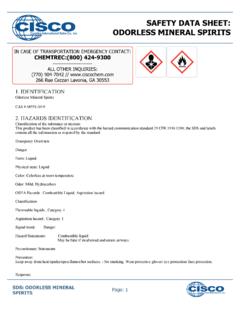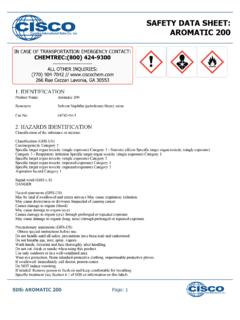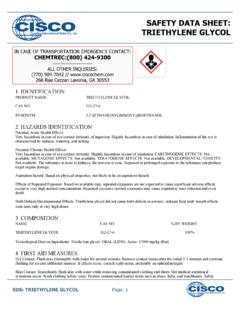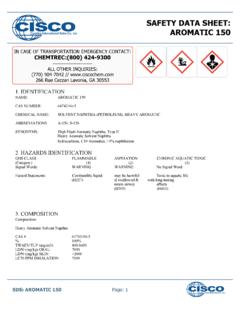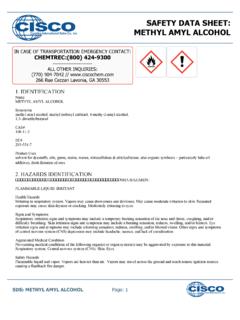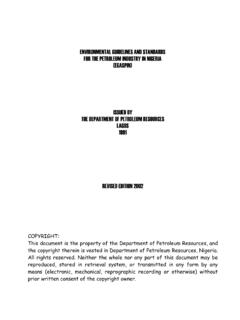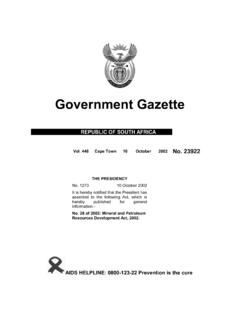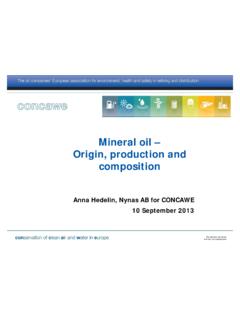Transcription of SAFETY DATA SHEET: REGULAR MINERAL SPIRITS
1 SAFETY data sheet : REGULAR MINERAL SPIRITS . IN CASE OF TRANSPORTATION EMERGENCY CONTACT: CHEMTREC:(800) 424-9300. ----------------------- ALL OTHER INQUIRIES: (770) 904-7042 // 266 Rue Cezzan Lavonia, GA 30553. 1. IDENTIFICATION. CAS # 8052-41-3. SYNONYMS: Naphtha, stoddard solvent, MINERAL SPIRITS , white spirit GENERIC CHEMICAL NAME: Naphtha, high paraffinic, stoddard solvent, naphtha solvent PRODUCT TYPE: Substance 2. HAZARDS IDENTIFICATION. APPEARANCE: COLORLESS LIQUID. ODOR: petroleum SOLVENT. SIGNAL WORD: WARNING!
2 FLAMMABLE LIQUID AND VAPOR. STATIC ACCUMULATING LIQUID CAN BECOME ELECTROSTATIC ALLY. IN BONDED AND GROUNDED EQUIPMENT; SPARKS MAY IGNITE LIQUID. AND VAPOR MAY CAUSE FLASH FIRE. HARMFUL IF SWALLOWED, CAN ENTER LUNGS AND CAUSE DAMAGE. MAY CAUSE CHRONIC EFFECTS. MAY CAUSE SKIN IRRITATION. MAY CAUSE EYE IRRITATION. MAY CAUSE RESPIRATORY TRACT IRRITATION. PROLONGED SKIN CONTACT MAY CAUSE IRRITATION. EXPOSURE ROUTES: INHALATION, INGESTION, SKIN AND/OR EYE CONTACT. PHYSICAL: KEEP AWAY FROM HEAT, SPARKS AND FLAME.
3 KEEP CONTAINER. TIGHTLY CLOSED. USE ONLY WITH ADEQUATE VENTILATION. AVOID SPARK PROMOTERS. GROUND/BOND CONTAINER AND. EQUIPMENT. THESE ALONE MAY BE INSUFFICIENT TO REMOVE. STATIC ELECTRICITY. EYES: AVOID CONTACT WITH EYES. WASH THOROUGHLY AFTER HANDLING. SDS: REGULAR MINERAL Page: 1. SPIRITS . SKIN: AVOID CONTACT WITH SKIN AND CLOTHING. WASH THOROUGHLY. AFTER HANDLING. SYMPTOMS OF. OVER EXPOSURE: IRRITATION TO EYES, NOSE, THROAT; DIZZINESS; DERMATITIS;. CHEMICAL PNEOMONITIS (aspiration liquid). MEDICAL CONDITIONS.
4 AGGRAVATED BY. EXPOSURE: PRE-EXISTING DISORDERS INVOLVING ANY TARGET ORGANS. MENTIONED IN THIS MSDS ARE BEING AT RISK MAY BE AGGRAVATED. BY OVER EXPOSURE TO THIS PRODUCT. CHRONIC EFFECTS: 3. COMPOSITION. CAS # COMPONENT PERCENT. 8052-41-3 STODDARD SOLVENT 100. HAZARDOUS CONSTITUENT(S) CONTAINED IN COMPLEX SUBSTANCES. CAS # COMPONENT PERCENT. 100-41-4 ETHYL BENZENE 111-84-2 NONANE 25551-13-7 TRIMETHYL BENZENE (mixed isomers). Component Regulatory Information This product may be regulated, have exposure limits or other information identified as the following: Stoddard solvent, Ethyl Benzene, Nonane, Trimethyl Benzene (See Section 8).
5 4. FIRST AID MEASURES. EYES. Check for and remove any contact lenses. Immediately flush eyes with plenty of water for at least 15 minutes, occasionally lifting the upper and lower eyelids. Get medical attention immediately. SKIN. In case of contact, immediately flush skin with plenty of water for at least 15 minutes while removing contaminated clothing and shoes. Wash clothing before reuse. Clean shoes thoroughly before reuse. Get medical attention immediately. INHALATION: Move exposed person to fresh air.
6 If not breathing, if breathing is irregular or if respiratory arrest occurs, provide artificial respiration or oxygen by trained personnel. Loosen tight clothing such as a collar, tie, belt or waistband. Get medical attention immediately. INGESTION: DO NOT INDUCE VOMITING. If conscious, rinse out mouth with water. Get medical attention immediately. NOTE TO PHYSICIANS. No specific treatment. Treat symptomatically. Contact poison treatment specialist immediately if large quantities have been ingested or inhaled.
7 SDS: REGULAR MINERAL Page: 2. SPIRITS . 5. FIRE FIGHTING MEASURES. Flammable Properties This product is a flammable static accumulating liquid. Static accumulating liquid can become electrostatically charged even in bonded and grounded equipment. Sparks may ignite liquid and vapor may cause flash fire. Static electricity accumulation may be significantly increased by the presence of small quantities of water or other contaminates. Restrict flow velocity to avoid build-up of static charge. Refer to NFPA 77, API 2003, and CENELEC CLC/TR 50404 for further guidance.
8 Extinguishing Media Use dry chemical, CO2, water spray (FOG) or foam Specific Hazards Arising from Chemical Elevated temperatures can lead to the formation of irritating fumes and vapors. Decomposition products may include the following materials: Carbon dioxide and Carbon monoxide. Protective Equipment and Precautions for Firefighters Fire-fighters should wear appropriate protective equipment and self-contained breathing apparatus (SCBA) with a full face-piece operated in positive pressure mode. 6. ACCIDENTAL RELEASE MEASURES.
9 Personal Precautions No action shall be taken involving any personal risk or without suitable training. Evacuate surrounding areas. Keep unnecessary and unprotected personnel from entering. Do not touch or walk through spilled material. Shut off all ignition sources. No flares, smoking or flames in hazard area. Avoid breathing vapor or mist. Provide adequate ventilation. Wear appropriate respirator when ventilation is inadequate. Put on appropriate personal protective equipment. Environmental Precautions Avoid dispersal of spilled material and runoff and contact with soil, waterways, drains and sewers.
10 Inform the relevant authorities if the product has caused environmental pollution. Methods for Containment Stop leak if without risk. Methods for Cleanup Move containers from spill area. Approach release from upwind. Absorb with an inert dry material and place in an appropriate waste disposal container. Dispose of via a licensed waste disposal contractor. 7. HANDLING AND STORAGE. Handling Procedures Eating, drinking, and smoking should be prohibited in areas where this material is handled, stored and processed.
